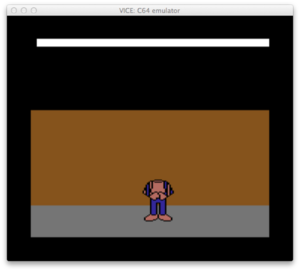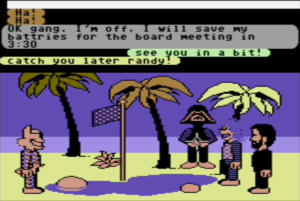NeoHabitat: Difference between revisions
Added some info regarding the start of NeoHabitat development |
Wrote up an intro blurb to the NeoHabitat article. This is now the most complete article on the wiki so far. |
||
| Line 7: | Line 7: | ||
}} | }} | ||
NeoHabitat is an open source modern revival of the classic [[Habitat]] virtual world, using the original client and a modern server backend. The public server is currently available at [http://www.neohabitat.org neohabitat.org]. You can also download the [https://github.com/frandallfarmer/neohabitat/ source code] yourself and spin up your own NeoHabitat server instance. | |||
=Open Sourcing= | =Open Sourcing= | ||
| Line 24: | Line 24: | ||
<nowiki> | <nowiki> | ||
Randy Farmer <randy.farmer@ | Randy Farmer <randy.farmer@xxx.com> | ||
Sep 30, 2014, 6:05 PM | Sep 30, 2014, 6:05 PM | ||
to habitat | to habitat | ||
| Line 55: | Line 55: | ||
<nowiki> | <nowiki> | ||
randy.farmer | Randy Farmer <randy.farmer@xxx.com> | ||
Oct 20, 2016, 12:25:00 PM | Oct 20, 2016, 12:25:00 PM | ||
to | to habitat | ||
Gang, | Gang, | ||
Latest revision as of 21:11, 10 April 2023
NeoHabitat is an open source modern revival of the classic Habitat virtual world, using the original client and a modern server backend. The public server is currently available at neohabitat.org. You can also download the source code yourself and spin up your own NeoHabitat server instance.
Open Sourcing
Fujitsu purchased the Habitat intellectual property in 1993, with Chip Morningstar and Randy Farmer helping to broker the deal between themselves and what was then LucasArts. In 2013, Alex Handy from the Museum of Art and Digital Entertainment made plans to setup an exhibit about LucasArts at the 2014 Game Developers Conference in San Francisco, CA. Whilst doing research for this, Handy contacted Chip Morningstar to see if he had any Habitat assets he could share that would be used in the exhibit. Chip replied back to Alex by sending him the entire Habitat client and server source code. According to Alex, Chip sent him the source as a joke because he didn't think he could do anything with then 26 year old code [1]. It was at this point that Alex asked Chip what it would take to get the code building again.
Around this time, Alex contacted Fujitsu and got in touch with the right department who would be able to sign off on open sourcing Habitat. Once the approval came through, a hackathon was planned to get things working again.
Development
Hackathon

A Hackathon was held on September 28th, 2014 at The Museum of Art and Digital Entertainment in Oakland, CA to restore Habitat to a working state. Notable attendees included Chip Morningstar, Randy Farmer and others. A Stratus machine from the time period Habitat operated was donated by Stratus to help with the effort and was brought to the museum by Stratus employee Paul Green. The Stratus didn't end up being used due to Quantum Link source code being missing which the Habitat server code needed to compile. Instead, a "wafer thin" server was created which would send a handcrafted packet to the client containing a basic region and avatar. This goal was reached by the end of the night and after 20 years, Habitat was alive again in some form.
Here is a follow up from Randy Farmer to the Habitat mailing list after the event
Randy Farmer <randy.farmer@xxx.com> Sep 30, 2014, 6:05 PM to habitat I wanted to thank everyone who participated in the Habitat Hackithon on Sunday... Though we didn't meet all our goals, we did get several things set up so that we will be able to do this in the foreseeable future. We confirmed that VICE will run Habitat/Club Caribe all the way to rendering the region while serving IO traffic, unmodified! (Win!) We have a working Stratus of the correct vintage up and on the network. We discovered that we need more original QLink header (and ideally actual code) to get the full server up on the Stratus. We were right on the cusp of having an extension to Qlink Reloaded that would mutliplex game traffic between a Habitat server and the client. We have a "Waffer Theen" Fake Habitat Server that I whipped up for Node.JS, which provided the data used to confirm the client working... What we need to do in short order: 1) Finish the QLR gateway code - MacMartin and Steve were very close, but there's nothing on the wiki so that we can pick up where they left off. 2) We need Paul's and Chip's comprehensive list of what's missing for the QLink build, and a strategy to get it (I think Alex said he'd lead this effort.) There's a lot of little other tasks, but these two are the burning ones. BTW, I whipped up another, more interesting "hatchery" contents vector, below. It is hand-crafted isn't confirmed to be working. Perhaps someone using Michael's hack can test it out? There's one more change I want to make to it (put the head on the avatar's shoulders), but only after I know it works. Thanks again for everything! It was awesome. Randy
After the Hackathon, The MADE was in contact with AOL to see if the original Quantum Link source code could be provided so the original server could be brought back online. Discussions took place for a couple of years, to the point where an employee who had been there a long time was able to find the files needed on old backups. Unfortunately, AOL was sold during this time and discussions closed down and the project had reached a dead end.
Habitat/Elko Server
On October 26th, 2016, Randy Farmer sent this message to the Habitat mailing list that was setup to co-ordinate the Hackathon efforts.
Randy Farmer <randy.farmer@xxx.com> Oct 20, 2016, 12:25:00 PM to habitat Gang, I've been working on an alternate server for Habitat based on the MADE open source PL1 code. I've been implementing it on top of Elko https://github.com/FUDCo/Elko - which is fitting, as it is the 9th generation descendant of those ideas, but the same creator(s). :-) The Habitat/Elko server project will be open source also. I hope to announce first week of November - it won't be fully functional yet, but I want to have end-to-end login with the client working. When I announce it, I want to do so to encourage more people to work on it with me to get it to completion by year's end. It will then be 30 years since the Habitat Promotional Video. It doesn't have a repository yet, as it's not ready for anyone. I'm pre-announcing it to this list because I need your help. I now have the server working well enough that I can attempt an end-to-end connection (exactly the one we tested at the Habitat Hack Day) but find I can't duplicate the conditions. Though I have the same C64 code and emulator, what I don't have is the QLink Reloaded server (and configuraion) someone there was running on hack day. How can I get that same configuration/software? This is one of the last steps before I package this for GitHub and announce it to the world. I want to get it working end-to-end well enough that at least one person can log in and do basic operations within a region. I'm thinking of setting up a Slack for this project - Does MADE have a Slack? Randy
- ^ Habitat for humanity: how a classic MMO got a second life, https://www.theverge.com/23025168/habitat-for-humanity-mmo-game
